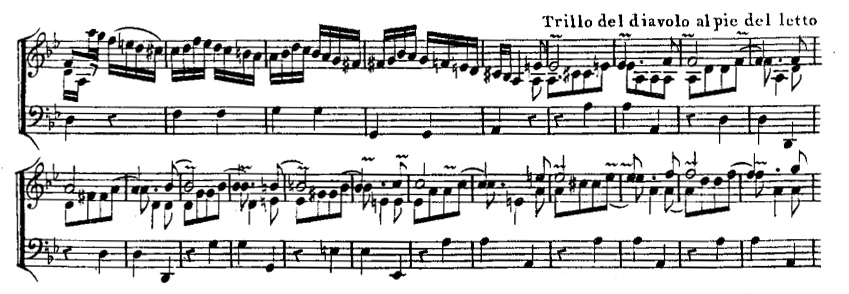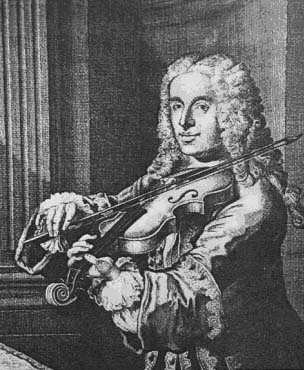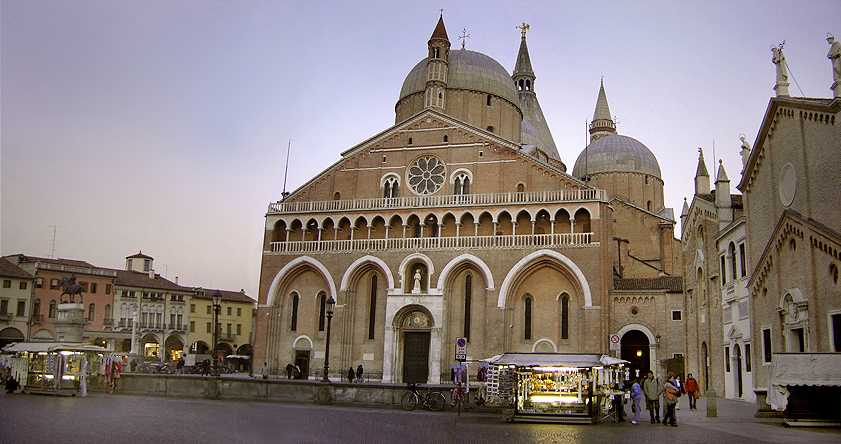|
Tartini
Giuseppe Tartini (8 April 1692 – 26 February 1770) was an Italian composer and violinist of the Baroque era born in the Republic of Venice. Tartini was a prolific composer, composing over a hundred of pieces for the violin with the majority of them being violin concertos. However, today, he is most famously remembered for his Violin Sonata in G Minor (the Devil's Trill Sonata). Biography Tartini was born on 8 April 1692 in Pirano (now part of Slovenia), a town on the peninsula of Istria, in the Republic of Venice to Gianantonio – native of Florence – and Caterina Zangrando, a descendant of one of the oldest aristocratic Piranese families. It appears Tartini's parents intended him to become a Franciscan friar and, in this way, he received basic musical training. Tartini studied violin first at the ''collegio delle Scuole Pie'' in Capodistria (today Koper). He studied law at the University of Padua, where he became skilled at fencing. After his father's death in 1710, he ma ... [...More Info...] [...Related Items...] OR: [Wikipedia] [Google] [Baidu] |
Devil's Trill Sonata
The Violin Sonata in G minor, B.g5, more familiarly known as the ''Devil's Trill Sonata'' ( Italian: ''Il trillo del diavolo''), is a work for solo violin (with figured bass accompaniment) by Giuseppe Tartini (1692–1770). It is the composer's best-known composition, notable for its technically difficult passages. A typical performance lasts 15 minutes. Background Tartini allegedly told the French astronomer Jérôme Lalande that he had dreamed that the devil had appeared to him and had asked to be Tartini's servant and teacher. At the end of the music lesson, Tartini handed the devil his violin to test his skill, which the devil began to play with virtuosity, delivering an intense and magnificent performance. So singularly beautiful and executed with such superior taste and precision was the Devil's performance, that the composer felt his breath taken away. The complete story is told by Tartini himself in Lalande's ''Voyage d'un François en Italie'': One night, in the year 171 ... [...More Info...] [...Related Items...] OR: [Wikipedia] [Google] [Baidu] |
Piran
Piran (; it, Pirano ) is a town in southwestern Slovenia on the Gulf of Piran on the Adriatic Sea. It is one of the three major towns of Slovenian Istria. The town is known for its medieval architecture, with narrow streets and compact houses. Piran is the administrative seat of the Municipality of Piran and one of Slovenia's major tourist attractions. Until the mid-20th century, Italian was the dominant language, but it was replaced by Slovene following the Istrian exodus. History In the pre-Roman era, the hills in the Piran area were inhabited by Illyrian Histri tribes who were farmers, hunters and fishermen. They were also pirates who disrupted Roman trade in the northern Adriatic. The Piran peninsula was incorporated into the Roman Empire in 178 and 177 BC and settled in the following years with rural homes ('' villae rusticae''). The decline of the Roman Empire, from the 5th century AD onward, and incursions by the Avars and Slavs at the end of the 6th century, pr ... [...More Info...] [...Related Items...] OR: [Wikipedia] [Google] [Baidu] |
Lipinski Stradivarius
The ''Lipinski Stradivarius'' is an antique violin constructed in 1715 by the Italian luthier Antonio Stradivari of Cremona, during Stradivari's "golden period" between 1700 and 1725. There are fewer than 650 extant Stradivarius violins in the world today, and the Lipinski is considered to be a particularly fine example. In 2012, it was appraised at US$5 million. History The earlier history of ''The Lipinski'' is unclear; Italian violinist and composer Giuseppe Tartini is the first reputed owner. Tartini, who in 1713 experienced a dream in which he allowed the devil to play his violin, heard a beautiful sonata which he was unable to compare with anything he had ever heard. Tartini, two years later, tried to reproduce the sound in his ''Devil's Trill Sonata''. Lipinski Tartini presented the violin to his pupil, Signor Salvini. According to a reminiscence of a certain von Krockow, who met the Polish violinist Karol Lipiński in Dresden in 1849, the young Lipinski, provided with a ... [...More Info...] [...Related Items...] OR: [Wikipedia] [Google] [Baidu] |
Karol Lipiński
Karol Józef Lipiński (30 October 1790 – 16 December 1861) was a Polish music composer and virtuoso violinist active during the partitions of Poland. The Karol Lipiński University of Music in Wrocław, Poland is named after him. Life Lipiński was born in Radzyń Podlaski. His father was Feliks Lipiński (1765–1847), and he had a younger brother of the same name Feliks (1815–1865). In 1810 he became the first violin and two years later the conductor of the opera orchestra at Lwów (now Lviv, Ukraine). In 1817 he went to Italy in the hope of hearing Niccolò Paganini. The two met in Milan, met daily to play, and even performed two concerts together in April 1818, which added immensely to Lipiński's reputation. Paganini dedicated his ''Burlesque Variations on "La Carnaval de Venise"'', Op. 10 for unaccompanied violin to Lipiński. Later, in 1827, Lipiński returned the honour by dedicating his "Three Caprices for Violin" to Paganini. In 1818 on his return to P ... [...More Info...] [...Related Items...] OR: [Wikipedia] [Google] [Baidu] |
Francesco Maria Veracini
Francesco Maria Veracini (1 February 1690 – 31 October 1768) was an Italian composer and violinist, perhaps best known for his sets of violin sonatas. As a composer, according to Manfred Bukofzer, "His individual, if not subjective, style has no precedent in baroque music and clearly heralds the end of the entire era", while Luigi Torchi maintained that "he rescued the imperiled music of the eighteenth century", His contemporary, Charles Burney, held that "he had certainly a great share of whim and caprice, but he built his freaks on a good foundation, being an excellent contrapuntist". The asteroid 10875 Veracini was named after him. Life Francesco Maria Veracini was born at about 8:00 a.m. on 1 February 1690 in the family house on the via Palazzuolo, parish of San Salvatore, Ognissanti, Florence. The second and only surviving son of Agostino Veracini, a pharmacist and undertaker (and ironically one of the few Veracinis who was not a violinist, even as an amateur) he w ... [...More Info...] [...Related Items...] OR: [Wikipedia] [Google] [Baidu] |
Francesco Antonio Vallotti
Francesco Antonio Vallotti (11 June 1697 – 10 January 1780) was an Italian composer, music theorist, and organist. Life He was born in Vercelli. He studied with G. A. Bissone at the church of St. Eusebius, and joined the Franciscan order in 1716. He was ordained as a priest in 1720. In 1722 he became an organist at St. Antonio in Padua, and would eventually become maestro there in 1730, succeeding maestro Calegari, and would hold that position for the next fifty years. Here he would meet and work with another theorist and composer named Giuseppe Tartini. Vallotti died in Padua on 10 January 1780. Theory Vallotti spent a great deal of thought on the theory of harmony and counterpoint. His theoretical endeavours would culminate in 1779 with the publishing of his 167-page, four volume work, ''Della scienza teorica e pratica della moderna musica'' (On the scientific theory and practice of modern music), just before the end of his life. One of his most frequently cited cont ... [...More Info...] [...Related Items...] OR: [Wikipedia] [Google] [Baidu] |
Basilica Di Sant'Antonio Da Padova
The Pontifical Basilica of Saint Anthony of Padua ( it, Basilica Pontificia di Sant'Antonio di Padova) is a Catholic church and minor basilica in Padua, Veneto, Northern Italy, dedicated to St. Anthony of Padua. Although the basilica is visited as a place of pilgrimage by people from all over the world, it is not the cathedral of the city, a title belonging to the Cathedral-Basilica of St. Mary of Padua. The basilica is known locally as "il Santo". It is one of the national shrines recognized by the Holy See. History Construction of the Basilica probably began around 1232, just one year after the death of St. Anthony. It was completed in 1310 although several structural modifications (including the falling of the ambulatory and the construction of a new choir screen) took place between the end of the 14th and the mid-15th century. The Saint, according to his will, had been buried in the small church of ''Santa Maria Mater Domini'', probably dating from the late 12th cent ... [...More Info...] [...Related Items...] OR: [Wikipedia] [Google] [Baidu] |
University Of Padua
The University of Padua ( it, Università degli Studi di Padova, UNIPD) is an Italian university located in the city of Padua, region of Veneto, northern Italy. The University of Padua was founded in 1222 by a group of students and teachers from Bologna. Padua is the second-oldest university in Italy and the world's fifth-oldest surviving university. In 2010, the university had approximately 65,000 students. In 2021, it was ranked second "best university" among Italian institutions of higher education with more than 40,000 students according to Censis institute, and among the best 200 universities in the world according to ARWU. History The university is conventionally said to have been founded in 1222 when a large group of students and professors left the University of Bologna in search of more academic freedom ('Libertas scholastica'). The first subjects to be taught were law and theology. The curriculum expanded rapidly, and by 1399 the institution had divided in two: a ''Uni ... [...More Info...] [...Related Items...] OR: [Wikipedia] [Google] [Baidu] |
Bohuslav Matěj Černohorský
Bohuslav Matěj Černohorský (Christened 16 February 1684, Nymburk, Bohemia – 1 July 1742, Graz, Austria) was a Czech composer, organist and teacher of the baroque era. He wrote among other works motets, other choral works (a fugue ''Laudetur Jesus Christus'' is cited by the Baroque Music Library as an excellent example of its kind) and organ solo works. Life He was a son of a Nymburk cantor named Samuel Černohorský. From 1700 to 1702 he studied philosophy at the Prague university. In 1704 Černohorský became a member of the Conventual Franciscan; later, in 1708 he was ordained as a priest. Nevertheless, in 1710 Černohorský was expelled from Czech lands for ten years, and he left for Assisi, Italy. From 1710 to 1715 he worked as an organist in the Basilica of San Francesco d'Assisi, and probably studied counterpoint with Giuseppe Tartini. He was called ''"Padre Boemo"'' in Italy. After the expiration of his punishment, he came back to Prague, where he devoted hi ... [...More Info...] [...Related Items...] OR: [Wikipedia] [Google] [Baidu] |
Padua
Padua ( ; it, Padova ; vec, Pàdova) is a city and ''comune'' in Veneto, northern Italy. Padua is on the river Bacchiglione, west of Venice. It is the capital of the province of Padua. It is also the economic and communications hub of the area. Padua's population is 214,000 (). The city is sometimes included, with Venice (Italian ''Venezia'') and Treviso, in the Padua-Treviso-Venice Metropolitan Area (PATREVE) which has a population of around 2,600,000. Padua stands on the Bacchiglione River, west of Venice and southeast of Vicenza. The Brenta River, which once ran through the city, still touches the northern districts. Its agricultural setting is the Venetian Plain (''Pianura Veneta''). To the city's south west lies the Euganaean Hills, praised by Lucan and Martial, Petrarch, Ugo Foscolo, and Shelley. Padua appears twice in the UNESCO World Heritage List: for its Botanical Garden, the most ancient of the world, and the 14th-century Frescoes, situated in dif ... [...More Info...] [...Related Items...] OR: [Wikipedia] [Google] [Baidu] |
The New Grove Dictionary Of Music And Musicians
''The New Grove Dictionary of Music and Musicians'' is an encyclopedic dictionary of music and musicians. Along with the German-language ''Die Musik in Geschichte und Gegenwart'', it is one of the largest reference works on the history and theory of music. Earlier editions were published under the titles ''A Dictionary of Music and Musicians'', and ''Grove's Dictionary of Music and Musicians''; the work has gone through several editions since the 19th century and is widely used. In recent years it has been made available as an electronic resource called ''Grove Music Online'', which is now an important part of ''Oxford Music Online''. ''A Dictionary of Music and Musicians'' ''A Dictionary of Music and Musicians'' was first published in London by Macmillan and Co. in four volumes (1879, 1880, 1883, 1889) edited by George Grove with an Appendix edited by J. A. Fuller Maitland in the fourth volume. An Index edited by Mrs. E. Wodehouse was issued as a separate volume in 1890. I ... [...More Info...] [...Related Items...] OR: [Wikipedia] [Google] [Baidu] |
Acoustics
Acoustics is a branch of physics that deals with the study of mechanical waves in gases, liquids, and solids including topics such as vibration, sound, ultrasound and infrasound. A scientist who works in the field of acoustics is an acoustician while someone working in the field of acoustics technology may be called an acoustical engineer. The application of acoustics is present in almost all aspects of modern society with the most obvious being the audio and noise control industries. Hearing is one of the most crucial means of survival in the animal world and speech is one of the most distinctive characteristics of human development and culture. Accordingly, the science of acoustics spreads across many facets of human society—music, medicine, architecture, industrial production, warfare and more. Likewise, animal species such as songbirds and frogs use sound and hearing as a key element of mating rituals or for marking territories. Art, craft, science and technology have ... [...More Info...] [...Related Items...] OR: [Wikipedia] [Google] [Baidu] |







